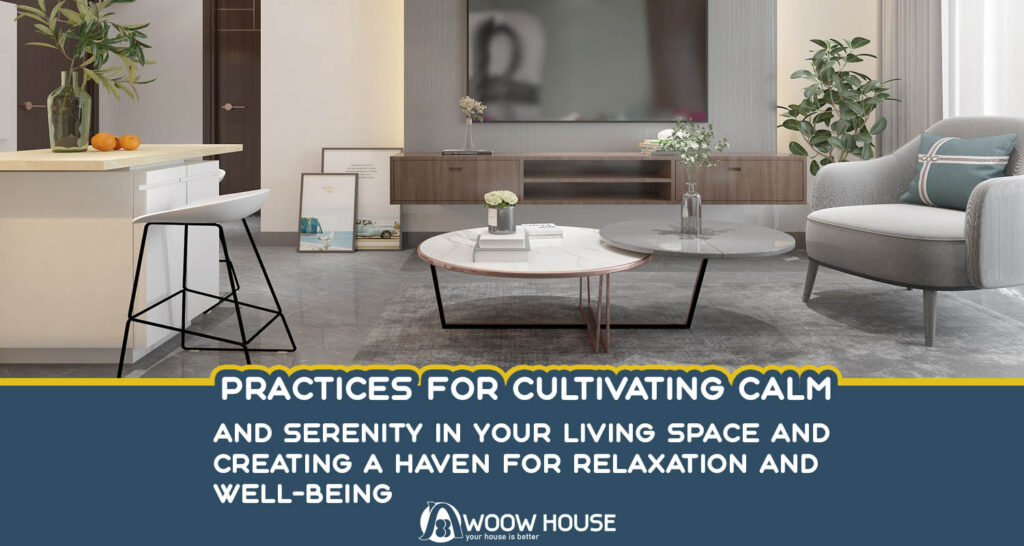In today’s fast-paced world, finding moments of calm and serenity is essential for maintaining balance and well-being. Your living space plays a significant role in promoting relaxation and tranquility, serving as a sanctuary where you can unwind, recharge, and rejuvenate. In this essay, we’ll explore practices for cultivating calm and serenity in your living space, from decluttering and creating designated relaxation zones to incorporating mindfulness techniques and embracing natural elements.
Declutter and Simplify:
Clutter can create chaos and overwhelm in your living space, hindering your ability to relax and find peace of mind. Decluttering and simplifying your surroundings is the first step in cultivating calm and serenity in your home.
Start Small: Begin decluttering one area of your home at a time, focusing on high-traffic areas such as the living room, bedroom, or kitchen. Sort through belongings and identify items that no longer serve a purpose or bring you joy, and set them aside for donation, recycling, or disposal.
Clear Surfaces: Keep surfaces clear of clutter to create a sense of spaciousness and order. Store frequently used items in designated storage areas such as shelves, drawers, or baskets, and minimize decorative accessories to prevent visual overwhelm.
Create Functional Storage: Invest in functional storage solutions such as shelves, cabinets, and storage ottomans to keep belongings organized and out of sight. Use labeled bins or containers to categorize and store items by type or frequency of use, making it easier to find what you need and maintain order.
Designate Relaxation Zones:
Creating designated relaxation zones in your living space allows you to carve out dedicated areas for rest, rejuvenation, and self-care. Whether it’s a cozy reading nook, a meditation corner, or a soothing bath retreat, having designated relaxation zones encourages mindfulness and promotes well-being.
Cozy Reading Nook: Designate a corner of your living room or bedroom as a cozy reading nook, complete with a comfortable armchair or chaise lounge, soft throw blankets, and a selection of books or magazines. Add a side table or floor lamp for added convenience and ambiance.
Meditation Corner: Create a tranquil meditation corner where you can practice mindfulness, meditation, or deep breathing exercises. Use floor cushions or a meditation bench for seating, and decorate the space with calming elements such as candles, incense, or nature-inspired artwork.
Soothing Bath Retreat: Transform your bathroom into a soothing retreat where you can unwind and pamper yourself after a long day. Fill your bathtub with warm water and add bath salts, essential oils, or bubble bath for a luxurious soak. Enhance the ambiance with soft lighting, candles, and relaxing music or nature sounds.
Incorporate Mindfulness Techniques:
Mindfulness techniques can help you cultivate a sense of presence, awareness, and inner peace in your living space. By incorporating mindfulness practices into your daily routine, you can reduce stress, anxiety, and negative thoughts, and enhance your overall well-being.
Mindful Breathing: Take a few moments each day to practice mindful breathing exercises to calm your mind and relax your body. Sit or lie down in a comfortable position, close your eyes, and focus on your breath as it enters and exits your body. Notice the sensations of each inhale and exhale, and let go of any tension or stress with each breath.
Gratitude Practice: Cultivate an attitude of gratitude by reflecting on the things you’re thankful for in your life. Keep a gratitude journal or create a gratitude altar in your living space where you can display meaningful objects or photos that remind you of the things you appreciate. Take a few moments each day to acknowledge and express gratitude for the blessings in your life.
Sensory Awareness: Engage your senses mindfully by paying attention to the sights, sounds, smells, tastes, and textures in your living space. Notice the colors, patterns, and textures of your surroundings, listen to the sounds of nature or soothing music, and savor the aromas of scented candles or fresh flowers. Allow yourself to fully immerse in the present moment and experience the beauty and richness of your environment.
Embrace Natural Elements:
Bringing elements of nature indoors can create a sense of calmness and connection with the outdoors, enhancing the overall ambiance of your living space. Incorporate natural materials, colors, and textures to evoke a sense of serenity and harmony in your home.
Indoor Plants: Add greenery to your living space with a variety of indoor plants, such as ferns, succulents, or peace lilies. Place plants in decorative pots or planters and display them on windowsills, shelves, or tabletops to bring life and vitality to your home.
Natural Materials: Use natural materials such as wood, stone, and rattan in your decor to add warmth and texture to your living space. Choose furniture, accessories, and accents made from natural materials to create a sense of connection with the earth and promote a calming and grounding atmosphere.
Biophilic Design: Incorporate biophilic design principles into your living space to enhance well-being and foster a deeper connection with nature. Bring in elements such as natural light, views of greenery, and natural textures to create a sense of harmony and balance in your home.
Cultivating calm and serenity in your living space is essential for promoting relaxation, rejuvenation, and overall well-being. By decluttering and simplifying your surroundings, creating designated relaxation zones, incorporating mindfulness techniques, and embracing natural elements, you can transform your home into a sanctuary where you can find peace and tranquility amidst the chaos of daily life. Whether you’re seeking moments of solitude and introspection or opportunities for rest and rejuvenation, these practices will help you create a living space that nurtures your mind, body, and soul, fostering a sense of harmony and balance that resonates throughout your life.







